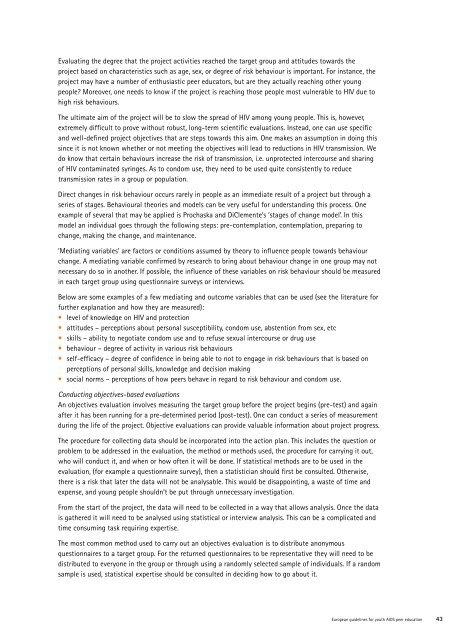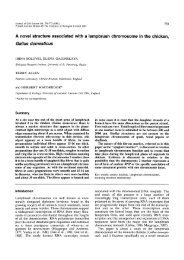European guidelines for youth AIDS peer education - University of ...
European guidelines for youth AIDS peer education - University of ...
European guidelines for youth AIDS peer education - University of ...
- No tags were found...
Create successful ePaper yourself
Turn your PDF publications into a flip-book with our unique Google optimized e-Paper software.
Evaluating the degree that the project activities reached the target group and attitudes towards theproject based on characteristics such as age, sex, or degree <strong>of</strong> risk behaviour is important. For instance, theproject may have a number <strong>of</strong> enthusiastic <strong>peer</strong> educators, but are they actually reaching other youngpeople? Moreover, one needs to know if the project is reaching those people most vulnerable to HIV due tohigh risk behaviours.The ultimate aim <strong>of</strong> the project will be to slow the spread <strong>of</strong> HIV among young people. This is, however,extremely difficult to prove without robust, long-term scientific evaluations. Instead, one can use specificand well-defined project objectives that are steps towards this aim. One makes an assumption in doing thissince it is not known whether or not meeting the objectives will lead to reductions in HIV transmission. Wedo know that certain behaviours increase the risk <strong>of</strong> transmission, i.e. unprotected intercourse and sharing<strong>of</strong> HIV contaminated syringes. As to condom use, they need to be used quite consistently to reducetransmission rates in a group or population.Direct changes in risk behaviour occurs rarely in people as an immediate result <strong>of</strong> a project but through aseries <strong>of</strong> stages. Behavioural theories and models can be very useful <strong>for</strong> understanding this process. Oneexample <strong>of</strong> several that may be applied is Prochaska and DiClemente’s ‘stages <strong>of</strong> change model’. In thismodel an individual goes through the following steps: pre-contemplation, contemplation, preparing tochange, making the change, and maintenance.‘Mediating variables’ are factors or conditions assumed by theory to influence people towards behaviourchange. A mediating variable confirmed by research to bring about behaviour change in one group may notnecessary do so in another. If possible, the influence <strong>of</strong> these variables on risk behaviour should be measuredin each target group using questionnaire surveys or interviews.Below are some examples <strong>of</strong> a few mediating and outcome variables that can be used (see the literature <strong>for</strong>further explanation and how they are measured):• level <strong>of</strong> knowledge on HIV and protection• attitudes – perceptions about personal susceptibility, condom use, abstention from sex, etc• skills – ability to negotiate condom use and to refuse sexual intercourse or drug use• behaviour – degree <strong>of</strong> activity in various risk behaviours• self-efficacy – degree <strong>of</strong> confidence in being able to not to engage in risk behaviours that is based onperceptions <strong>of</strong> personal skills, knowledge and decision making• social norms – perceptions <strong>of</strong> how <strong>peer</strong>s behave in regard to risk behaviour and condom use.Conducting objectives-based evaluationsAn objectives evaluation involves measuring the target group be<strong>for</strong>e the project begins (pre-test) and againafter it has been running <strong>for</strong> a pre-determined period (post-test). One can conduct a series <strong>of</strong> measurementduring the life <strong>of</strong> the project. Objective evaluations can provide valuable in<strong>for</strong>mation about project progress.The procedure <strong>for</strong> collecting data should be incorporated into the action plan. This includes the question orproblem to be addressed in the evaluation, the method or methods used, the procedure <strong>for</strong> carrying it out,who will conduct it, and when or how <strong>of</strong>ten it will be done. If statistical methods are to be used in theevaluation, (<strong>for</strong> example a questionnaire survey), then a statistician should first be consulted. Otherwise,there is a risk that later the data will not be analysable. This would be disappointing, a waste <strong>of</strong> time andexpense, and young people shouldn’t be put through unnecessary investigation.From the start <strong>of</strong> the project, the data will need to be collected in a way that allows analysis. Once the datais gathered it will need to be analysed using statistical or interview analysis. This can be a complicated andtime consuming task requiring expertise.The most common method used to carry out an objectives evaluation is to distribute anonymousquestionnaires to a target group. For the returned questionnaires to be representative they will need to bedistributed to everyone in the group or through using a randomly selected sample <strong>of</strong> individuals. If a randomsample is used, statistical expertise should be consulted in deciding how to go about it.<strong>European</strong> <strong>guidelines</strong> <strong>for</strong> <strong>youth</strong> <strong>AIDS</strong> <strong>peer</strong> <strong>education</strong> 43
















